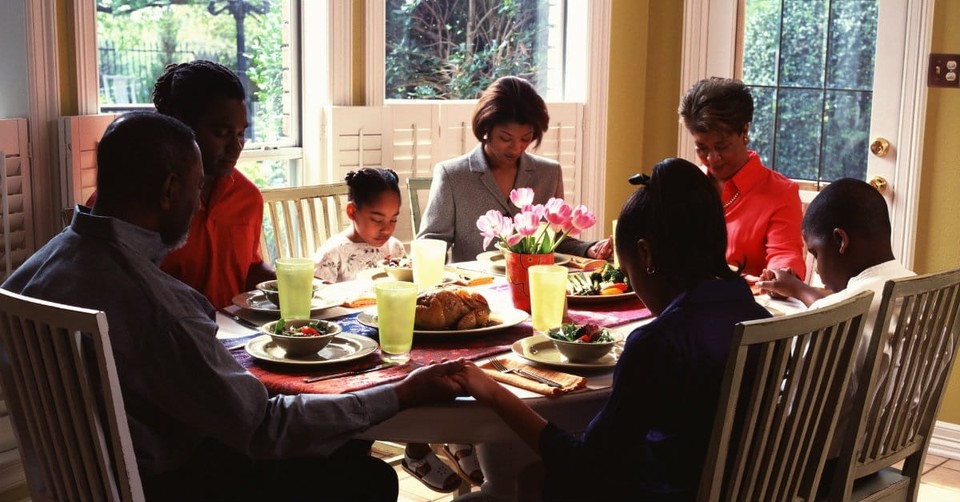7 Ways to Make Saying Grace a Trend

Picture a family at dinner —Mom, Dad, and the kids sitting around the table together, smiling and enjoying themselves. Are you looking at the family circa the 1950s? Surprisingly, this may not be the case. Several recent studies show that families of today are eating together more often than they have in decades; that more than one in four families is eating together nearly every night. If you are such a family, or would like to become one, you have an ideal opportunity to instill within each one of you an appreciation of God’s unfailing daily provision.
Mealtime during Jesus’ day had significant meaning beyond just eating. The associated rituals of hospitality were more than highly regarded, too. Because hotels and restaurants were rare or non-existent, you were expected to take in any traveling stranger who might knock on your door seeking food and shelter. In addition, the offering of food had currency and was an expression of social standing. What one served was a measure not only of one’s wealth but of the guest’s importance.
One important custom, universal in Bible times, was the blessing of the meal. Jesus loved to eat—it wouldn’t be an exaggeration to say (with the best possible implications) that he loved to party! The Bible is full of illustrations centering around food, banquets, feasts, and festivals. Many of Jesus’ teachings were accompanied by food, and he always gave thanks to his Father first.
Call it what you will—saying a prayer, giving thanks, mindful meditation, or a reflective pause—saying grace before a meal is a good practice that not only pleases God but yields a multitude of benefits for the pray-er as well. In the same way that bread needs yeast, saying grace—giving thanks—makes a meal complete; it’s a habit worth modeling, teaching, and keeping. Some of these benefits: saying grace acknowledges the presence of God in your life, enhances flavor and improves digestion (really, it does!), invites concern for others, and prompts faith conversations, which in turn promotes family bonding.
More often than not, people do want to say grace before a meal and have every intention of doing so, but simply forget or lack the motivation. Here are seven ways in which your family can make grace “trending” now:
1. Acknowledge that you’d like to make grace a part of every evening meal (and/or lunch or breakfast—whatever works for you). Get a commitment from every family member. Be creative in generating enthusiasm for the idea. Assure everyone that the process won’t be long or complicated—the food is not going to get cold, and the voices won’t be drowned out by growling tummies. Remind yourself that giving thanks is a prayer, and as with any prayer, you have the ear of the Creator of the moon and son, the heavens and earth. Isn’t that a stunning thought?
2. Think of saying grace as a time to reboot—a breather or reset button in the midst of the hectic pace we so often set for ourselves. A deep breath slows everything down so the meal can be enjoyed. Holding hands makes it even better. How often, after all, do siblings hold hands—especially as they get older? What a wonderful way to connect.
3. Need a visual reminder? Keep a book of graces on or beside the table. Or perhaps you have a little wall space just begging for a statement. Display a small collection of crosses; you’ll be amazed at how good they make you feel.
4. Use the saying of grace to get stragglers to the meal on time. And be a good example, Mom and Dad—park all electronic devices in the other room, away from earshot. You’ve just now created an environment to talk to each other. What you say in the grace can spark dialogue that will carry you through the entire meal.
5. Start with what you know. It can be as simple as “Thank you, God, for the food we eat.” Four-year-old Wyatt likes to say: “Thank you, God, for building all the people.” Build from there. Some families like to sing their graces or repeat rhymed graces together. This well-loved grace might be a good starting point, especially if your children are younger: “God is great, God is good. Let us thank Him for our food. By his hands we all are fed. Thank you for our daily bread. Amen.”
6. Give everyone a turn at saying grace. This will be harder and initially more intimidating for some, but the stumbling will soon give way, and with practice the words will flow smoothly. Saying grace aloud has other benefits, too. It stimulates memory, improves pronunciation, sharpens focus, and increases vocabulary and articulation skills. Make a game of it. Who can say grace without using any filler words (you know, like, okay, basically, etc.)?
7. Some families like to bookend the meal with a grace on either end. One is usually shorter and the other is a bit longer, intentionally including prayers for others and praises for the day’s blessings. Try this (from a collection titled Lutheran Common Table Prayer) as a beginning to the end of the meal: “O give thanks to the Lord, for He is good, for His love endures forever. Amen.”
Grace trending now? It is—for lots of families. And what a great idea for yours! To keep things fresh, say a little different grace every day—or maybe start with a staple like one of the above and add variations or new elements as you become more comfortable. Maybe a thank you for something that happened or a prayer for someone to be healed. Variety keeps the practice from becoming mechanical. Always remember that you’re talking to God. Picture him sitting at the table with you. Now that’s very 21st century. Image courtesy: ©Thinkstock/Creatas Publication date: April 11, 2017 Originally published September 11, 2017.





